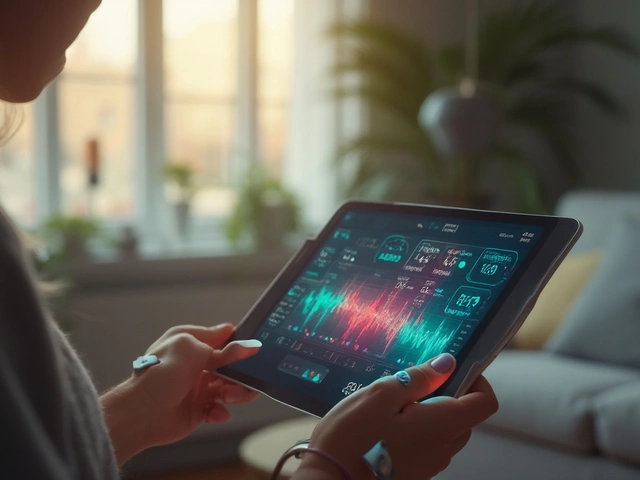Ever thought about how cool it would be to control your own body's signals just like a superhero? That's kind of what biofeedback is all about! It's a technique that's helping people improve their cognitive performance by teaching them to manage their own biological functions like heart rate, muscle tension, and even brainwaves. By tuning in to what's going on inside your body, you can actually train yourself to think more clearly, remember better, and reduce stress.
If that sounds like something out of a sci-fi movie, you're not far off. Biofeedback uses sensors to give you real-time information about your body's processes. Think of it as a mirror reflecting what's happening inside you, so you can learn to change it. Over time, this kind of training can help improve focus and memory, which is pretty valuable whether you're cramming for exams or giving a big presentation at work.
- Understanding Biofeedback Basics
- The Science Behind the Magic
- Real-life Applications of Biofeedback
- Getting Started with Biofeedback Techniques
Understanding Biofeedback Basics
Biofeedback might sound like a techy buzzword, but it's actually a straightforward concept. At its heart, it's about gaining control over certain functions of your body that typically happen automatically. What's cool is that this control can translate into better cognitive performance.
Think of it like getting signals from your body saying, "Hey, your heart rate is rocketing because of stress!" Biofeedback devices pick up on these signals and display them. When you can see them, it becomes easier to manage them.
How Does It Work?
Simply put, biofeedback devices usually come with sensors attached to your skin. These might monitor things like heart rate, muscle tension, or even brainwaves, which is the exciting part for boosting your brain training. The data's shown on a screen, allowing you to respond by learning new techniques to adjust these metrics. For example, slowing your breathing when you notice an elevated heart rate.
Types of Biofeedback
- Heart Rate Variability (HRV): Focuses on your heart rate to help improve stress management.
- Electromyography (EMG): Measures muscle tension, useful for those looking to ease tightness or pain.
- Neurofeedback: Often called EEG biofeedback, this targets brain rhythms, which is directly tied to cognitive enhancement.
Curious about how common this is? A recent survey showed that a surprising 40% of people using biofeedback reported significant improvements in concentration and memory within a few months. Pretty neat, huh?
If you're just starting out, there's no need to splurge. Simple apps or wearable devices can help you dip your toes into the world of biofeedback without breaking the bank. So why not give it a shot and see how it can help you boost your brainpower?
The Science Behind the Magic
So, what's really happening behind the scenes with biofeedback? At its core, it's all about harnessing the power of information. Biofeedback devices collect data from your body—like heart rate, brain waves, and skin temperature—to help you understand and eventually alter these signals.
One of the coolest tools out there is EEG biofeedback, which focuses on brain waves. It turns out, our brains are super active, with different waves corresponding to different states, like relaxation or alertness. This type of biofeedback, also known as neurofeedback, can help people achieve a better balance of these waves, leading to improved cognitive performance.
How Does It Work?
Imagine playing a video game with your mind. That's kind of what neurofeedback is like. Sensors are attached to your scalp to detect your brain waves while you watch a visual display that changes based on your brain activity. With practice, you learn to adjust your mental state to control the game, which in turn strengthens your ability to focus and think clearly.
Scientific studies continue to support the efficacy of biofeedback. For instance, a study in 2023 found that participants who used heart rate variability (HRV) biofeedback saw measurable reductions in stress levels and significant improvements in memory tasks.
Benefits Backed by Science
Why are folks getting so excited about this? Because biofeedback isn't just about kicking back and relaxing; it's legitimately effective. Research has shown that regular biofeedback sessions can enhance attention and reduce anxiety, making it a popular tool among students and professionals alike.
| Biofeedback Type | Common Uses |
|---|---|
| EEG/Neurofeedback | Focus, attention, relaxation |
| HRV Biofeedback | Stress reduction, emotional regulation |
| EMG Biofeedback | Muscle relaxation, pain management |
It's important to note that while biofeedback shows promise, it’s not a one-size-fits-all solution. Different techniques suit different needs, so figuring out what works best for you is key.

Real-life Applications of Biofeedback
Biofeedback isn't just a neat party trick—it's being used in tons of practical ways all around us. One big area where it's making waves is in boosting cognitive performance. Schools and workplaces are starting to use biofeedback tools to help students and employees improve focus and reduce stress. By learning how to manage physiological responses, people can think more clearly and stay calm under pressure.
For athletes, biofeedback offers a competitive edge by helping them control their breathing, heart rate, and muscle tension. This can translate into better performance and faster recovery times. Picture a runner using biofeedback to monitor their heart rate, so they can push their limits without overdoing it.
Health and Wellness
Biofeedback is also making a difference in the healthcare world. It's being used to treat chronic conditions like migraines and hypertension by teaching patients to relax their bodies and minds. This can sometimes reduce the need for medication. Mental health professionals are using it, too, helping folks with anxiety or PTSD learn how to control their stress responses.
- Neurofeedback: This form of biofeedback focuses on brainwaves, teaching users to influence patterns linked to attention or relaxation. It's been used in cases of ADHD, offering an alternative to medication.
- Heart Rate Variability (HRV) Training: By monitoring HRV, people can learn to manage stress and improve emotional regulation.
Everyday Tech Savvy
Then there are wearables—think smartwatches that provide biofeedback data. These cool gadgets help folks monitor their everyday activity levels and stress, sometimes buzzing to remind them to take a breather and reset.
Here's a fun stat: According to recent industry reports, about 25% of people using fitness wearables engage with biofeedback features for wellness and performance enhancement.
| Biofeedback Users | Purpose |
|---|---|
| 25% | Wellness & Performance Enhancement |
As the tech evolves, we're only scratching the surface of what biofeedback can do. Whether you're looking to kick stress to the curb or step up your mental game, these applications show just how versatile and practical biofeedback can be.
Getting Started with Biofeedback Techniques
Jumping into the world of biofeedback can feel like you're embarking on a new adventure. The first move is understanding what gear you'll need. You might have heard about fancy devices, but let me tell you, starting out doesn't have to be that complex. Here's a quick guide to help you dive in smoothly.
Choosing the Right Equipment
Biosensors, wearables, and apps are out there ready to help you connect with your body. You can grab biofeedback devices tailored to different signals. Options range from heart rate monitors to brainwave equipment. For starters, heart rate variability (HRV) monitors are a solid pick. They can help gauge stress levels and meditate more effectively.
Find What Works for You
Not every technique fits everyone. What's crucial is trying a few to see what clicks. Many people find great success with breathing exercises. Here's a quick practice to ease in:
- Find a quiet spot and sit comfortably.
- Hook up your device—maybe your phone with a handy app.
- Watch the feedback. Try deep, slow breaths.
- Monitor how your numbers react. Adjust accordingly to see improvements.
Consistency is key. Like going to the gym, biofeedback benefits show over time. A daily five to ten-minute routine can make a world of difference.
Track Your Progress
Watching your improvement is motivating. Many devices and apps offer data tracking to help you see changes. A quick glance every few days can keep you in tune with your practice. Keep an eye out for positive trends like lowered stress markers or enhanced focus.
Luckily, most of these tools are becoming more affordable and accessible, letting anyone who’s curious jump in and explore. Whether you’re looking to boost cognitive performance for work, study, or just for fun, biofeedback might just be your new secret weapon.





